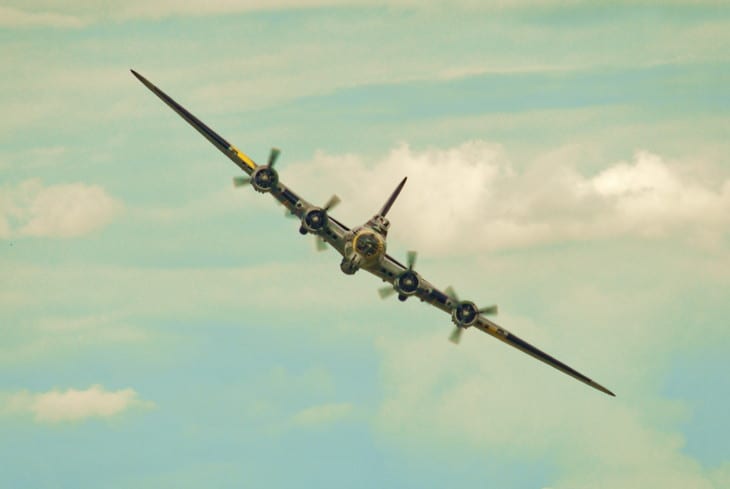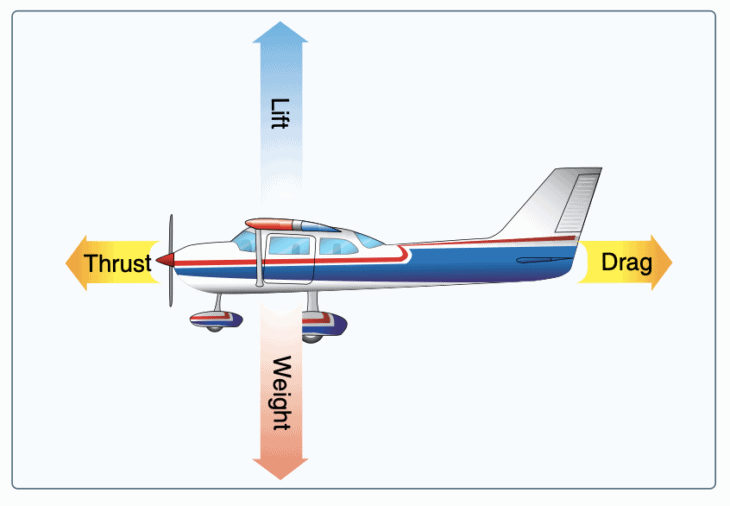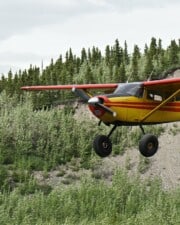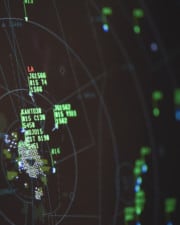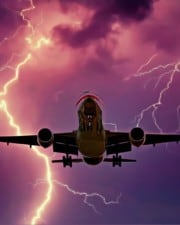Turning an airplane seems very easy, even when you’re sitting in the cockpit. Move the control yoke or stick to the left or right, and the plane will follow. Planes are designed to be stable and easy to fly, after all. But when you take a deep dive into the aerodynamics of what keeps a plane aloft and how to make it turn, things can get very complicated. For instance, what is a coordinated turn?
In the simplest terms, a coordinated turn is one in which the forces acting on the airplane in a turn are perfectly balanced. The plane is turning, and its occupants are not being pushed or pulled in any direction in their seats.
Forces of Flight
To better understand how an airplane stays aloft and how things change during turns, we often discuss the forces broken down into individual components.
Straight and Level Flight
There are four forces to look at for basic, unaccelerated, non-turning, non-climbing, or descending flight.
- Lift—The force created by the wings that acts opposite gravity.
- Weight—The mass of the airplane being pulled towards the earth by gravity.
- Thrust—The power of the engine that pulls the plane through the air and acts opposite drag.
- Drag—The resistance of the airplane to being moved forward through the air.
If a plane is flying at a level altitude and not speeding up or slowing down, then lift must be equal and opposite weight, and thrust must be equal and opposite drag.
Turning Flight
If the pilot wants to turn in a particular direction, then the wings are banked in that direction. The lift being made by the wings is no longer pointed up and opposite gravity. It remains perpendicular to the wing.
If you break that diagonal line into its components, it means that the portion acting opposite weight is reduced slightly. Unless the pilot takes further action, the plane will begin losing altitude.
But it also means that a portion of the lift made by the wing is now pulling the plane into the turn. The force created by the wings is what makes an airplane turn. It’s called the horizontal component of lift.
Centrifugal and Centripetal Forces
When you’re in a car driving on a level road, and you make a sudden fast turn to the right, what happens to your body on the inside of the car? It’s thrown to the left.
Why does that happen? As Newton’s Third Law of Motion states, “For every action, there is an equal and opposite reaction.”
Sitting in your car, when you jerk the wheel to the right, you create an action. The force that pulls the car into the turn is known as centripetal force.
But in reaction, everything is thrown left. That apparent force is called centrifugal force.
The same thing happens in an airplane, but the pilot has a lot more control over those forces than the driver of a car does.
Flight Controls
Airplanes have three primary flight controls. Each control moves the airplane around a flight axis, and each motion has a name.
- Ailerons roll the plane around the longitudinal axis.
- The rudder yaws the plane around the vertical axis.
- The elevator pitches the plane around its lateral axis.
How Do You Do Coordinated Turns?
To make the turn happen, the pilot has to do three (possibly four) things simultaneously. Here’s a look at which controls are used in a coordinated turn.
Assuming that they enter the turn from straight and level unaccelerated flight, the first step is to use the ailerons to roll into the turn. The control wheel controls the ailerons.
At the same time, the pilot needs to apply some rudder input in the same direction. The rudder is controlled with the foot pedals. The amount of rudder the pilot puts in will determine if the turn is slipping (too little rudder), skidding (too much rudder), or coordinated (just right).
As the plane rolls into the turn, the vertical lift is reduced, and the plane may begin losing altitude. Some elevator may be needed to keep the nose level and to hold the altitude. The elevator is controlled by pushing or pulling the yoke. In this case, you would pull up on the yoke to hold your altitude.
Depending on how steep the turn is, the pilot might need to add some power if the plane begins to slow down. Very steep turns or low-performance airplanes require a significant increase in power. The power is controlled by the throttle, a lever control at the pilot’s right hand.
How Much Rudder Does a Pilot Need to Keep a Turn Coordinated?
That’s a great question. The answer is, “Just enough, but not too much!” In practical terms, it depends on the plane you’re flying and how steep the turn is.
If a turn is perfectly coordinated, the only force felt in the cockpit is a slight pressure straight down into your seat. If your body is pressed left or right, then the turn is slipping or skidding. The use of the body’s kinesthetic sense is sometimes called “flying by the seat of your pants.”
Instruments—Turn Coordinator
The body’s internal mechanisms are far from tuned for flying airplanes. Humans evolved for walking with their feet firmly planted, not for winging their way across the clouds. Luckily, several simple instruments are used in the cockpit to help the pilot gauge the necessary rudder pressure.
The simplest is known as the inclinometer, or simply “The Ball.” This small instrument is usually mounted inside the turn coordinator, mounted right in front of the pilot. You can find it in any airplane, but it does move from place to place. It is often incorporated into the main attitude indicator on an electronic primary flight display (PFD).
The ball moves as the forces of flight act on it, so it’s a quick and easy reference for what the pilot should do. Pilots are taught to “step on the ball,” which means that whatever direction the ball is deflected, the pilot should press that rudder pedal.

The goal is to keep the ball right in the middle, which indicates a perfectly coordinated turn.
References ▾
Related Posts
